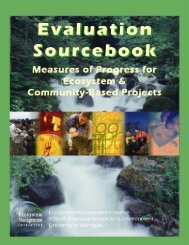A Guide to Strategic Planning for Rural Communities - USDA Rural ...
A Guide to Strategic Planning for Rural Communities - USDA Rural ...
A Guide to Strategic Planning for Rural Communities - USDA Rural ...
You also want an ePaper? Increase the reach of your titles
YUMPU automatically turns print PDFs into web optimized ePapers that Google loves.
plan. Perhaps you thought you could build a new airport, but you later learned that your<br />
proposed site was a <strong>to</strong>xic waste area. As your situation changes, so will your plan.<br />
However, you should not immediately revise your strategic plan every time you identify<br />
something that needs <strong>to</strong> be changed. <strong>Planning</strong> experience has shown that an annual review cycle<br />
works well and no more than two per year should be allowed. Constant changes can weaken the<br />
plan and lead community members <strong>to</strong> lose interest in the process. The strategic plan should<br />
describe an official, public process <strong>to</strong> change the plan. This will allow those who helped develop<br />
the plan <strong>to</strong> learn about the proposed changes and participate in refining and approving them. Just<br />
as the whole community participated <strong>to</strong> create the plan, they should also help improve it.<br />
4. Continuing Evaluation<br />
Every once in a while, you should s<strong>to</strong>p and look at what went right or wrong, learn why it<br />
happened and try <strong>to</strong> prevent similar problems in the future. The strategic plan should describe<br />
how and when the community will evaluate the process, outputs and outcomes of the strategic<br />
plan. If you already know who will do your evaluations, include them in the planning process.<br />
They can tell you what kind of data is needed <strong>to</strong> do a good evaluation.<br />
Process<br />
Did people complete their tasks on time and within budget? A process evaluation helps answer<br />
questions such as "What changes are needed in how we are carrying out our plan?" and "How can<br />
we do it better?" It may be possible <strong>to</strong> do a process evaluation at the end of the first year or it<br />
may be more effective <strong>to</strong> do it during the strategic plan’s annual review and update.<br />
Outputs<br />
An output evaluation asks, "How much of what we planned <strong>to</strong> do did we actually accomplish?”<br />
Outputs are usually things that can be counted and that you can see completed in a short<br />
timeframe. They result from activities in the strategic plan and work programs. (e.g., jobs<br />
created, houses built, programs started).<br />
Outcomes<br />
In evaluating the end results of implementing a strategic plan, ask “How successful were we in<br />
tackling the long-term problems in our community?” or “How successful were we in achieving<br />
our long-term goals?” Outcomes are usually long term (e.g., fewer people living in poverty) and<br />
linked <strong>to</strong> problems and goals. They are hard <strong>to</strong> evaluate because many fac<strong>to</strong>rs that influence a<br />
community’s well-being are out of its control (e.g., weather, the world trade).<br />
11






